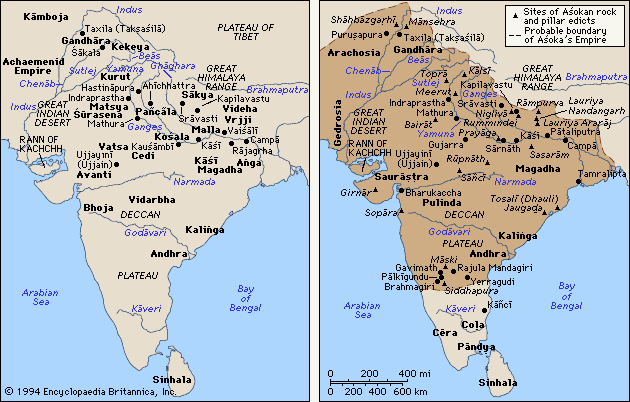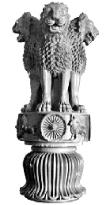Public Works
Askoka was a king from 269 to his death around 232 BCE. He
bellieved in budhist principles and used the religion to govern. He created
several large pillar and rock edicts to announce these ideas to the people.
Some are still around today. Below is the location of the
surviving edicts. Almost all have been translated. The writing
looks something like this. For a translation click here. The statue is considered
the flag of the Mauryan empire. The circle in the center symbolizes
budhist principles.
For a translation click here. The statue is considered
the flag of the Mauryan empire. The circle in the center symbolizes
budhist principles.
 MAURYAN ART
MAURYAN ART
The Mauryans excelled in the art of stone carving. Mauryan stone
sculptures are characterized by a polished mirror-like surface, which
has retained its luster to this day. This is evident in smooth-surfaced
pillars, figural sculptures, such as the famous statue of a beautiful
Yakshi, or a female figure with a flywhisk found at Didarganj in Patna.
The smoothness was achieved by rubbing the surface of the stone with fine-grained
sand buffing it with cloth or animal skin. The animal figures of lion,
bull, or elephant, atop Mauryan pillars also have this highly polished
surface. The most important pillar is the one that depicts four lions sitting
back-to-back, which has been adopted by the Indian government as its national
emblem. These magnificent monolithic pillars have been found in Sanchi,
Sarnath, Vaishali, and some other places. They were erected to spread
the gospel of Buddhism. The floral patterns on these pillars and the use
of pillars themselves show Persian influence. It is said that the Persian
palace at Persipolis was the inspiration behind these pillars. Mauryan
artisans also carved out a number of rock-cut caves throughout the empire.
The Buddhist caves in the Barabar hills near Gaya in Bihar are famous.
They also built a number of Buddhist stupas. It is said that during the
time of Ashoka 84,000 stupas were built in India. (http://www.indianvisit.com/ivnew/thecountry/history/mauryanempire.htm)
